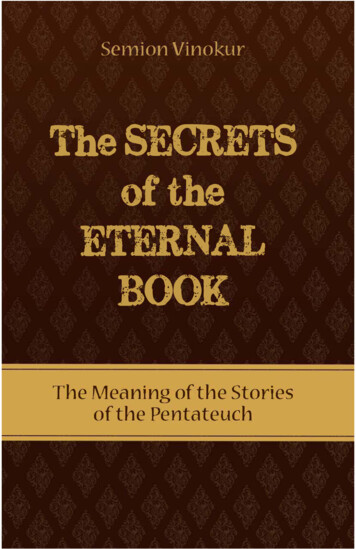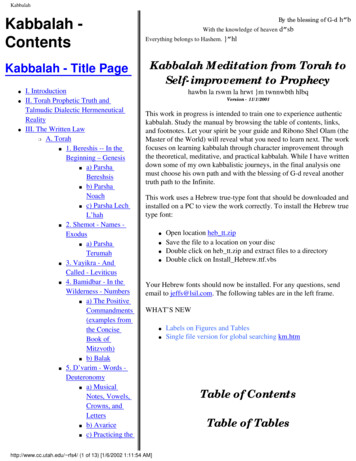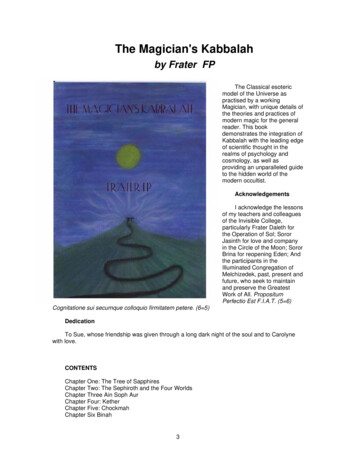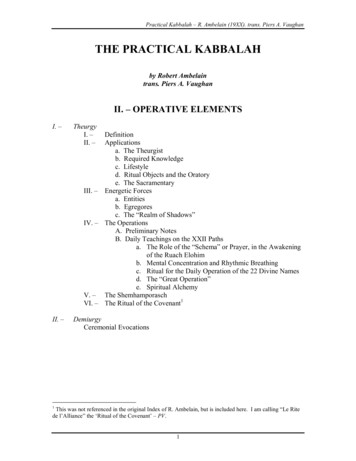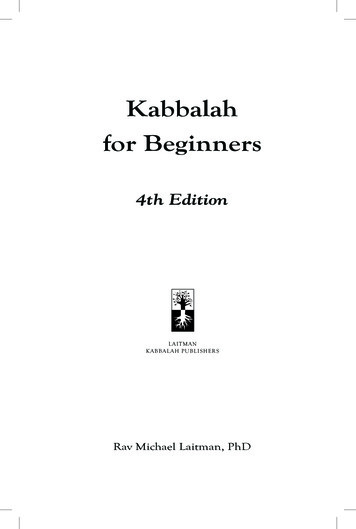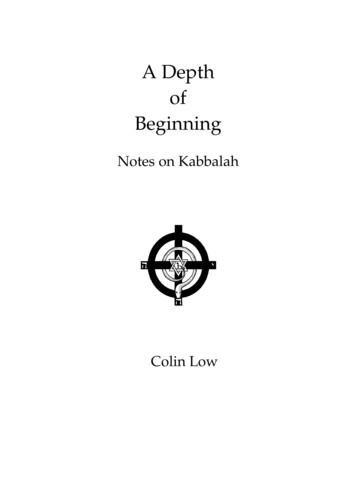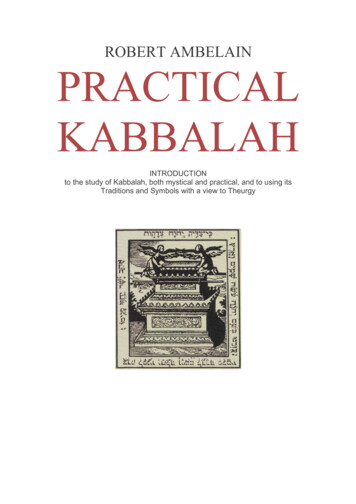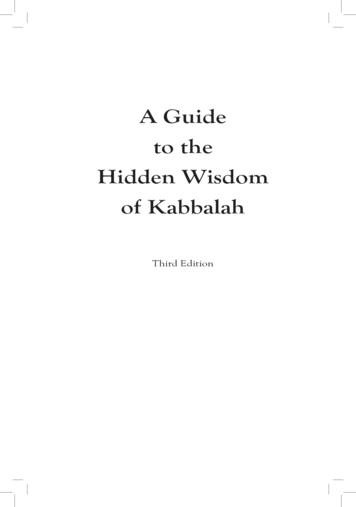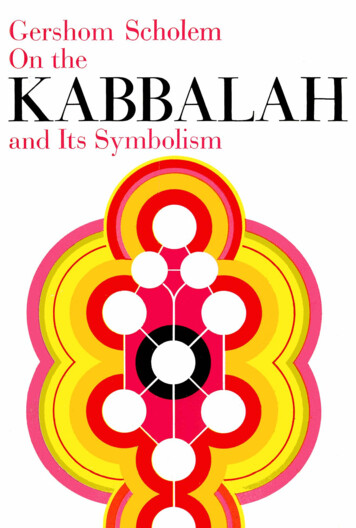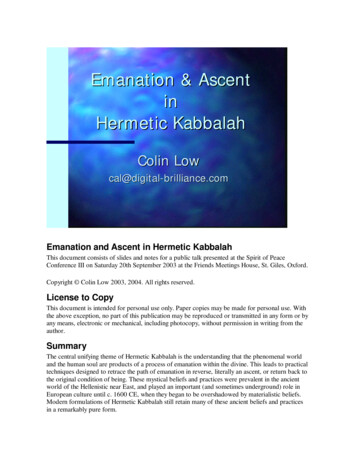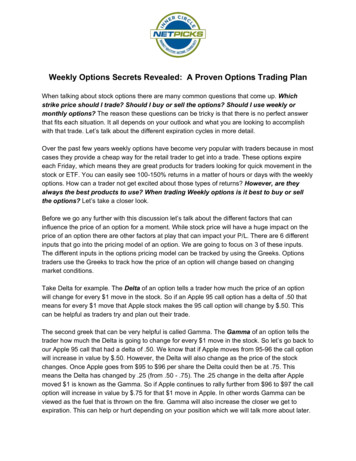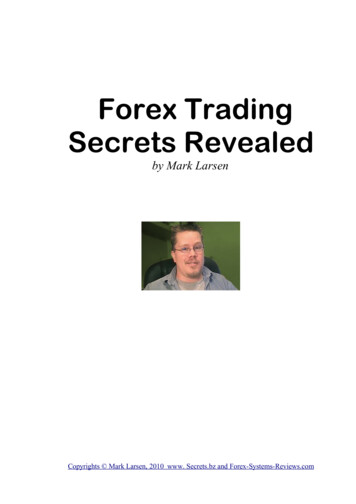
Transcription
Kabbalah RevealedRav Michael Laitman, PhDIntroduction by: Professor Ervin Laszlo
Kabbalah RevealedThe Ordinary Person’s Guideto a More Peaceful LifeLAIT MANKABBALAH PUBLISHERSRav Michael Laitman, PhDIntroduction by: Professor Ervin Laszlo
KABBALAH REVEALEDThe Ordinary Person’s Guide to a More Peaceful LifeCopyright 2006 by MICHAEL LAITMANAll rights reservedPublished by Laitman Kabbalah Publisherswww.kabbalah.infoinfo@kabbalah.info1057 Steeles Avenue West, Suite 532, Toronto, ON, M2R 3X1, Canada194 Quentin Rd, 2nd floor, Brooklyn, New York, 11223, USAPrinted in CanadaNo part of this book may be used or reproducedin any manner without written permission of the publisher,except in the case of brief quotations embodiedin critical articles or reviews.Library of Congress Cataloging-in-Publication DataLaitman, Michael.Kabbalah revealed:the ordinary person’s guide to a more peaceful life /Michael Laitmanp. cm.ISBN 0-9781590-0-41. Cabalah. 2. Mysticism—Judaism.3. Spiritual life—Judaism. I. Title.BM525.L253 2006296.1’6—dc222006031322Copy Editor: Claire GerusLayout and Drawings: Baruch KhovovCover Design: Richard AquanPrinting and Post Production: Uri LaitmanExecutive Editor: Chaim RatzCover photo: Manuscripts of Kabbalist Yehuda Ashlag,courtesy of Bnei Baruch archives and Studio Yaniv, Israel.FIRST EDITION: JANUARY 2007
KABBALAH REVEALEDTABLE OF CONTENTSBiographies .9Introduction .13CHAPTER 1 - KABBALAH: THEN AND NOW . 19THE MASTER PLAN . 19THE CRADLE OF SCIENCE . 21Other Routes .23The Big Questions .24KABBALAH STEPS IN .24The Engine of Change .25Taking the Driver’s Seat .26HIDING, SEEKING, BUT NOT FINDING .28The Global Crisis Has a Happy End .30Egoism Is a Catch-22 .30THE NECESSITY OF ALTRUISM .32Enhanced Perception .34The Time Is Now.36IN A NUTSHELL . 37CHAPTER 2 - THE GREATEST WISH OF ALL . 39SPRINGBOARD FOR GROWTH .40Behind Closed Doors . 41The Evolution of Desires .43HANDLING DESIRES .46A New Desire in Town . 47A New Method for a New Desire .48Tikkun—the Correction of the Will to Receive .50IN A NUTSHELL .52CHAPTER 3 - THE ORIGIN OF CREATION .53THE SPIRITUAL WORLDS .54Four Basic Phases .55THE QUEST FOR THE THOUGHT OF CREATION . 61THE ROUTE .66ADAM HA RISHON—THE COMMON SOUL . 71IN A NUTSHELL .73
CHAPTER 4 - OUR UNIVERSE . 75THE PYRAMID . 76As Above, So Below .78UP THE LADDER .79THE DESIRE FOR SPIRITUALITY .84IN A NUTSHELL .90CHAPTER 5 - WHOSE REALITY IS REALITY? . 93THREE BOUNDARIES IN LEARNING KABBALAH .96First Boundary—What We Perceive.96Second Boundary—Where We Perceive .96Third Boundary—Who Perceives .97PERCEPTION OF REALITY .100A Nonexistent Reality .103The Measurement Mechanism. 105The Sixth Sense .106Where There’s a Way, There Was a Will . 109The Thought of Creation. 111Reshimot—Back to the Future . 113IN A NUTSHELL . 116CHAPTER 6 - THE (NARROW) ROAD TO FREEDOM .119THE DARK BEFORE THE DAWN . 121A Brave New World in Four Steps .126KNOW YOUR LIMITS .129The Reins of Life . 131Changing Society to Change Myself .133FOUR FACTORS .135CHOOSING THE RIGHT ENVIRONMENT FOR CORRECTION . 138No Anarchists . 142THE EGO’S INEVITABLE DEATH . 143The Cure . 145Fake Freedom . 147Conditions for Free Choice . 149IMPLEMENTING FREE CHOICE.150Faith.150Reason . 151IN A NUTSHELL .153FURTHER READING.157
BIOGRAPHIESR AV M I C H A E L L A I T M A N , P H DRav Michael Laitman, PhD, is an international authorityon authentic Kabbalah. His background is highly unusualfor one renowned in the spiritual: he was educated in thesciences, holds an MS in bio-cybernetics, and has pursueda successful scientific career, later turning to Kabbalahto further his scientific research. He received his PhD inPhilosophy and Kabbalah from the Moscow Institute ofPhilosophy at the Russian Academy of Sciences.In 1976, he began studying Kabbalah, and has beenresearching it ever since. In 1979, seeking new avenuesin Kabbalah, he came across Kabbalist Rabbi BaruchShalom HaLevi Ashlag (1906-1991), the firstborn son,and successor of Kabbalist Rabbi Yehuda Leib HaLeviAshlag (1884-1954), known as Baal HaSulam for his9
10K ABBALAH R EVEALEDSulam (Ladder) commentary on The Book of Zohar. Michael Laitman was so impressed with Baal HaSulam’sson, that he became Baruch Ashlag’s closest discipleand personal assistant, spending the bulk of his timein the company of his revered mentor, and absorbing asmuch as he could of his teachings.Today, he is regarded as the foremost authority onKabbalah, having authored thirty books on the subject,translated into ten languages. His live lessons are broadcast daily on cable TV and internet around the world.In recent years, he has become a sought-after lecturer inacademic circles in the United States and Europe.Dr. Laitman is the founder and president of Bnei Baruch - Kabbalah Education and Research Institute, whichoperates the largest and most extensive internet site onthe subject of Kabbalah, www.kabbalah.info. The websiteprovides unlimited access to Kabbalistic texts and media in over twenty languages, with 1.4 million hits permonth. Since the year 2000, the Encyclopedia Britannicarecognizes kabbalah.info as one of the largest internet sitesfor both number of visitors and quantity of educationaland informational materials on the science of Kabbalah.
Biographies11P RO F E S S O R E RV I N L A S Z L OProf. Ervin Laszlo, who graciously wrote the introduction to this book, is the founder and foremost exponentof Systems Philosophy and General Evolution Theory.Born in Budapest, Hungary in 1932, Laszlo made hisdebut as a concert pianist at the age of fifteen in NewYork, an event reported in Life, Time, Newsweek, and theinternational media.Prof. Laszlo turned to science and philosophy in hismid-twenties and began publishing books and articles in1963. In 1970 he received the State Doctorate, the highest degree of the Sorbonne, the University of Paris. Insubsequent years he was awarded honorary PhDs in theUnited States, Canada, Finland, Russia, and Hungary.In recognition of his commitment to global understanding and development, he received the 2001Goi Award, the Peace Prize of Japan. He has writtenseventy-two books, translated into as many as eighteenlanguages.
INTRODUCTIONI am delighted and honored to have been asked to writethe introduction to Dr. Laitman’s Kabbalah Revealed: TheOrdinary Person’s Guide to a More Peaceful Life. Not only isthe author a dear personal friend, he is, in my view, theforemost Kabbalist alive today, a genuine representative ofa wisdom that has been kept secret for two millennia. Nowthat the wisdom of Kabbalah, among other indigenouswisdoms, is emerging full scale, I believe no other personis better suited to expound on its essence.In today’s world, the emergence of Kabbalah as anauthentic means of instruction is of unique significance.It can help us regain awareness of the wisdom that ourforefathers possessed, and which we have forgotten.Indigenous wisdoms are appearing today preciselybecause our customary, mechanical school of thoughthas failed to provide the well-being and sustainability ithad promised. A Chinese proverb warns, “If we do not13
14K ABBALAH R EVEALEDchange direction, we are likely to end up exactly wherewe are headed.” When applied to contemporary humanity, this could prove disastrous:Climate change is threatening to turn vast areas ofour planet into unlivable, lifeless soil, unsuitable for human habitation and inadequate for food production.Additionally, most of the world’s economies have become less self-sufficient. This is ominously coupled withthe worldwide diminution of food reserves. There is lessavailable freshwater for well over half of the world’s population. On average, more than 6,000 children perish eachday from diarrhea caused by polluted water.In many parts of the world, violence and terrorismhave become the favored means to resolve conflicts.Hence, there is deepening insecurity in both rich andpoor countries. Islamic fundamentalism is spreadingthroughout the Muslim world, neo-Nazi and other extremist movements are sprouting in Europe, and religious fanaticism is appearing the world over.Thus, our very tenure on this planet is in question.However, global breakdown is not mandatory. Wecan turn the tide, and the following scenario, too, is entirely possible:As the latter part of this book will show, we can pulltogether and pursue shared objectives of peace and sustainability. Business leaders can recognize the groundswell of change and respond with goods and services thatmeet the shift in demand.
Introduction15Global news and entertainment media might explorefresh perspectives and emerging social and cultural innovations, and a new vision of self and nature will emergeon the internet, on television, and in communicationnetworks of enterprises and communities.In civil society, a culture of alternative living and responsible values will lend support to policies of social andecological sustainability. Measures will be taken to protectthe environment, create effective food and resource distribution systems, develop and use sustainable energy, transport, and agricultural technologies.In this positive outlook, funds will be redirectedfrom the military and defense establishments to serve theneeds of the people. Supported by these developments,national, international, and intercultural mistrust, ethnic and racial conflicts, oppression, economic inequity,and gender inequality will all give way to mutual trustand respect. People and communities will readily cooperate and form productive partnerships.Thus, rather than breaking down in conflict and war,humanity will break through—not merely to a sustainableworld of self-reliant and cooperating communities, butto a joyous future of peace, tranquility and complete selffulfillment.A peaceful and sustainable world can await us all,but alas, we are not presently headed in this direction.Einstein told us, “The significant problems we face cannot be solved at the same level of thinking at which wecreated them.” Yet, we are trying to do just that. We are
16K ABBALAH R EVEALEDtrying to fight terrorism, poverty, crime, environmentaldegradation, disease, and other “sicknesses of civilization” with the same methods that produced them in thefirst place. We are attempting technological fixes andtemporary remedial measures. Yet we have not musteredthe will, nor the vision to create a lasting and fundamental change.PLANETARY CONSCIOUSNESSIn light of today’s global crises, humankind has begun toseek new avenues and modes of thinking. Such modesare the ancient, albeit very pertinent, indigenous wisdoms. To them, planetary consciousness is not merely anancillary notion, but their very essence. When we studythese modes, we realize that the new planetary consciousness is actually an old, perennial consciousness; only nowit is being rediscovered.Indeed, it is high time that planetary consciousnesswas rediscovered. We used to think that the typical, “normal” human consciousness is what we capture with ourfive senses. We considered everything else imaginary.The common perception was that we ended where ourskin ended. Other views were considered “new age,”“mystical,” or “esoteric.” Ideas that we somehow belongtogether, that there is a context in which we are parts of agreater whole, have been considered the exception in thehistory of civilization.But if we look at the history of ideas, we will find thatthe truth is quite the opposite. The reductionist, mecha-
Introduction17nistic, and fragmented thinking that evolved in the Western world over the last 300 years is not the norm, but theexception. Other cultures do not share this view. Eventhe West did not adhere to it prior to the emergence ofthe mechanistic worldview that it inherited as an application (or rather, misapplication) of Newton’s philosophyof nature.In other cultures, as well as in the Western world preceding modern times, the prevailing consciousness wasone of belonging, of oneness. Most traditional culturesdo not agree that people have nothing in common butpassing interests that happen to coincide.The classical roots of all the wisdom traditions areconcepts of a “planetary consciousness.” This term defines the awareness of our shared fate as human beings,as citizens of this planet. If we are to sustain our existence, if we are to ensure that our children and grandchildren have a secure and sustainable future, we must fostera planetary consciousness.To move forward, we must cultivate a mindset thatenables us to form a united human family, a planetarycivilization. However, this civilization should not be amonolithic culture where everyone follows the sameideas, and one person or nation dictates those ideasto everybody else. Rather, it should be a diverse civilization whose elements join together to maintain anddevelop the whole system, the planetary civilization ofhumankind.
18K ABBALAH R EVEALEDThis diversity is the element of harmony, the elementof peace. Every society that has survived has possessed it.Only Western and westernized societies have forgotten it.In the process of creating technical and economic progress, they have fragmented the integrity, the oneness ofthe system. It is high time we restore it.As I learned through my acquaintance with Dr. Laitman’s writings, Kabbalah in its authentic form not onlypromotes the concept of oneness and the integrity of humanity and the universe, it also offers practical measuresto restore it when lost.It is my heartfelt recommendation to read carefully through this book, as it provides much more thangeneral knowledge about an ancient wisdom. It alsoprovides a key to ensure the well-being of humanity inthese critical times, when we face the unprecedentedchallenge of choosing between the devolutionary pathleading to worldwide breakdown, and the evolutionarypath that can bring us to a world of peace, harmony,well-being, and sustainability.Ervin Laszlo
1KABBALAH: THEN AND NOWTHE MASTER PLANIt is no secret that Kabbalah did not begin with today’s Hollywood trendy hype. It has actually been around for thousands of years. When it first appeared, people were muchcloser to Nature than they are today. They felt an intimacywith Nature and nurtured their relationship with it.In those days, they had little reason to be detachedfrom Nature. They weren’t as self-centered and alienatedfrom their natural environment as we are today. Indeed,at that time, humanity was an inseparable part of Natureand nurtured its intimacy with it.In addition, humankind did not know enough aboutNature to feel secure; instead, we were afraid of naturalforces, which impelled us to relate to Nature as a forcesuperior to our own.19
20K ABBALAH R EVEALEDBeing intimate with Nature, on the one hand, andafraid of it, on the other hand, people aspired not onlyto learn about their surrounding world, but even moreimportant, to determine what or who governed it.In those early days, people couldn’t hide from Nature’s elements as they do today; they couldn’t avoid itshardships as we do in our “manmade” world. And mostimportant, the fear of Nature, and at the same time, thecloseness to it, urged many to search for and discoverNature’s plan for them, and coincidentally, for all of us.Those pioneers in Nature’s research wanted to knowif Nature actually had a goal, and if so, what humanity’srole might be in this Master Plan. Those individuals whoreceived the highest level of knowledge, that of the Master Plan, are known as “Kabbalists.”A unique individual among those pioneers was Abraham. When he discovered the Master Plan, he not onlyresearched it in depth, but first and foremost taught it toothers. He realized that the only guarantee against misery and fear was for people to fully understand Nature’splan for them. And once he realized this, he spared noeffort teaching whoever wished to learn. For this reason,Abraham became the first Kabbalist to start a dynastyof Kabbalah teachers: The most worthy students becamethe next generation of teachers, who then passed on theknowledge to the next generation of students.Kabbalists refer to the designer of the Master Plan as“the Creator,” and to the Plan itself as “The Thought ofCreation.” In other words, and this is important, when
Kabbalah: Then and Now21Kabbalists talk about Nature or Nature’s laws, they aretalking about the Creator. And vise versa, when they aretalking about the Creator, they are talking about Natureor Nature’s laws. These terms are synonymous.The term, “Kabbalist,” comes from the Hebrewword, Kabbalah (“reception”). The original lan- guage of Kabbalah is Hebrew, a language developed especially by and for Kabbalists, to help them communicatewith one another about spiritual matters. Many Kabbalahbooks have been written in other languages, too, but thebasic terms are always in Hebrew.To a Kabbalist, the term, “Creator,” does not signify a supernatural, distinct entity, but the next degreethat a human being should reach when pursuing higherknowledge. The Hebrew word for Creator is Boreh, andcontains two words: Bo (come) and Re’eh (see). Thus, theword, “Creator,” is a personal invitation to experiencethe spiritual world.THE CRADLE OF SCIENCEThe knowledge that the first Kabbalists acquired didmore than help them understand how things workedbehind the scenes. With it, they were able to explainthe natural phenomena we all encounter. It was onlynatural, therefore, that they became teachers, and thatthe knowledge they passed on to us became the basis forboth ancient and modern sciences.
22K ABBALAH R EVEALEDPerhaps we think of Kabbalists as secluded peoplehiding in dim, candle-lit chambers, writing magical scriptures. Well, until the end of the 20th century, Kabbalahwas indeed kept secret. The clandestine approach towardKabbalah evoked numerous tales and legends surrounding its nature. Although most of these tales are false, theystill baffle and confuse even the most rigorous thinkers. Gottfried Leibnitz, a great mathematician andphilosopher, candidly expressed his thoughts onhow secrecy had affected Kabbalah: “Because man didnot have the right key to the secret, the thirst for knowledge was ultimately reduced to all sorts of trivia and superstitions that brought forward a sort of ‘vulgar Kabbalah’ that has little in common with the true Kabbalah, aswell as various fantasies under the false name of magic,and this is what fills the books.”But Kabbalah was not always secret. In fact, the firstKabbalists were very open about their knowledge, and atthe same time, very much involved with their societies.Often, Kabbalists were their nation’s leaders. Of all theseleaders, King David is probably the best known exampleof a great Kabbalist who was also a great leader.The involvement of Kabbalists in their societieshelped their contemporary scholars develop the basis ofwhat we now know as “Western philosophy,” which laterbecame the basis of modern science. In that regard, here’swhat Johannes Reuchlin, a humanist, classics scholar, and
Kabbalah: Then and Now23expert in ancient languages and traditions, writes in hisbook, De Arte Cabbalistica: “My teacher, Pythagoras, thefather of philosophy, took his teaching from Kabbalists He was the first to translate the word, Kabbalah, unknown to his contemporaries, to the Greek word philosophy Kabbalah does not let us live our lives in the dust,but elevates our mind to the height of knowledge.”OTHER ROUTESBut philosophers were not Kabbalists. Because theydid not study Kabbalah, they couldn’t fully understandthe depth of Kabbalistic knowledge. As a result, knowledge that should have been developed and treated in avery specific way was developed and treated incorrectly.When Kabbalistic knowledge migrated to other parts ofthe world, where there were no Kabbalists at the time, italso took a different course.Thus, humanity made a detour. Although Westernphilosophy incorporated parts of the Kabbalistic knowledge, it ended up taking an entirely different direction.Western philosophy generated sciences that researchedour material world, that which we perceive with our fivesenses. But Kabbalah is a science that studies what happens beyond what our senses perceive. The changed emphasis drove humanity in the opposite direction fromthe original knowledge that Kabbalists obtained. Thischange in direction took humanity on a detour whoseconsequences we will explore in the following chapter.
24K ABBALAH R EVEALEDTHE BIG QUESTIONSKabbalah became hidden about 2,000 years ago. Thereason was simple—there was no demand for it. Sincethat time, humanity has occupied itself with developingmonotheistic religions, and later on, science. Both werecreated to answer man’s most fundamental questions:“What is our place in the world, in the universe?” Whatis the purpose of our existence?” In other words, “Whywere we born?”But today, more than ever before, many people feelthat what has worked for 2,000 years no longer meets theirneeds. The answers provided by religion and science nolonger satisfy them. These people are looking elsewhere foranswers to the most basic questions about the purpose oflife. They turn to Eastern teachings, fortune-telling, magicand mysticism. And some turn to Kabbalah.Because Kabbalah was formulated to answer thesefundamental questions, the answers it provides are directlyrelated to them. By rediscovering ancient answers aboutthe meaning of life, we are literally mending the rupturebetween humanity and Nature that occurred when weturned away from Kabbalah and toward philosophy.KABBALAH STEPS INKabbalah made its “debut” about 5,000 years ago in Mesopotamia, an ancient country in today’s Iraq. Mesopotamia was not only the birthplace of Kabbalah, but of allancient teachings and mysticism. In those days, people be-
Kabbalah: Then and Now25lieved in many different teachings, often following morethan one teaching at a time. Astrology, fortune-telling,numerology, magic, witchcraft, spells, evil eye—all thoseand more were developed and thrived in Mesopotamia,the cultural center of the ancient world.As long as people were happy with their beliefs, theyfelt no need for change. People wanted to know that theirlives would be safe, and what they needed to do to makethem enjoyable. They were not asking about the originof life, or most important, who or what had created therules of life.At first, this may seem like a slight difference. But actually, the difference between asking about life, and asking about the rules that shape life, is like the differencebetween learning how to drive a car and learning how tomake one. It’s a totally different level of knowledge.THE ENGINE OF CHANGEDesires don’t just pop out of the blue. They form unconsciously within us and surface only when they becomesomething definable, such as, “I want a pizza.” Beforethat, desires are either not felt, or at most, felt as generalrestlessness. We’ve all experienced that sense of wantingsomething but not quite knowing what it is. Well, it is adesire that has not yet ripened.Plato once said, “Necessity is the mother of invention,” and he was right. Similarly, Kabbalah teaches usthat the only way we can learn anything is by first wanting to learn it. It’s a very simple formula: when we wantsomething, we do what it takes to get it. We make the
26K ABBALAH R EVEALEDtime, muster the energy, and develop the necessary skills.It turns out that the engine of change is desire.The way our desires evolve both defines and designsthe entire history of humanity. As humankind’s desiresdeveloped, they urged people to study their environment so they could fulfill their wishes. Unlike minerals,plants, and animals, people constantly evolve. For everygeneration, and for each person, desires grow strongerand stronger.TAKING THE DRIVER’S SEATThis engine of change—desire—is made of five levels, zerothrough four. Kabbalists refer to this engine as “a will toreceive pleasure,” or simply, “the will to receive.” WhenKabbalah first appeared, some 5,000 years ago, the willto receive was at level zero. Today, as you might haveguessed, we are at level four—the most intense level.But in the early days when the will to receive was atlevel zero, desires were not strong enough to separate usfrom Nature and from each other. In those days, this oneness with Nature, which today many of us pay good moneyto re-learn in meditation classes (and let’s face it, not always successfully) was the natural way of life. People didn’tknow any other way. They didn’t even know that theycould be separated from Nature, nor did they want to be.In fact, in those days, humanity’s communicationwith Nature and with each other flowed so seamlessly,words were not even necessary; instead, people communicated by thought, much like telepathy. It was a time
Kabbalah: Then and Now27of unity, and the whole of humanity was like a singlenation.But while still in Mesopotamia, a change occurred:people’s desires started to grow and they became moreegoistic. People began to want to change Nature and useit for themselves. Instead of wanting to adapt themselvesto Nature, they began wanting to change Nature to fittheir needs. They grew detached from
Philosophy and Kabbalah from the Moscow Institute of Philosophy at the Russian Academy of Sciences. In 1976, he began studying Kabbalah, and has been researching it ever since. In 1979, seeking new avenues in Kabbalah, he came across Kabbalist Rabbi Ba
